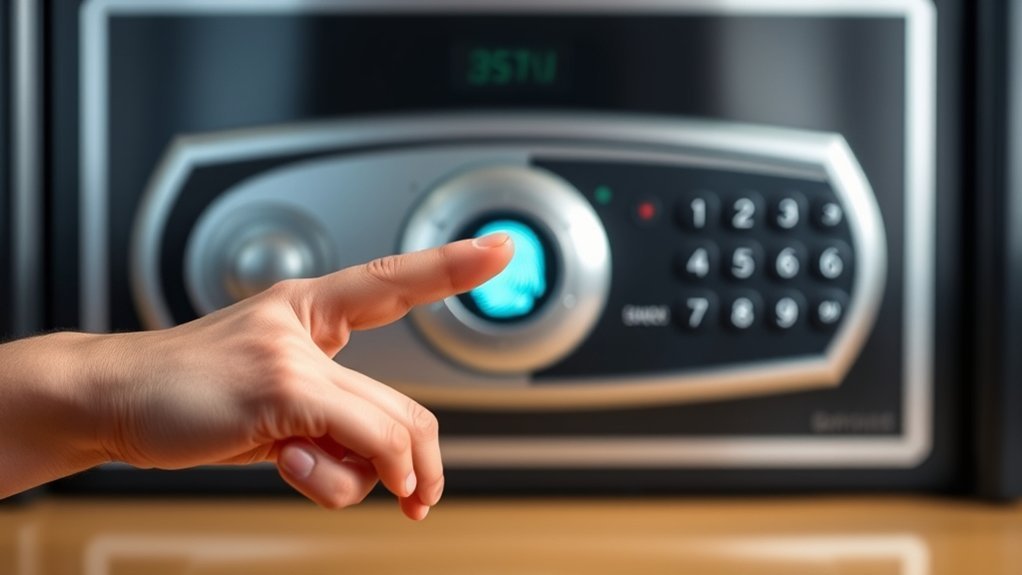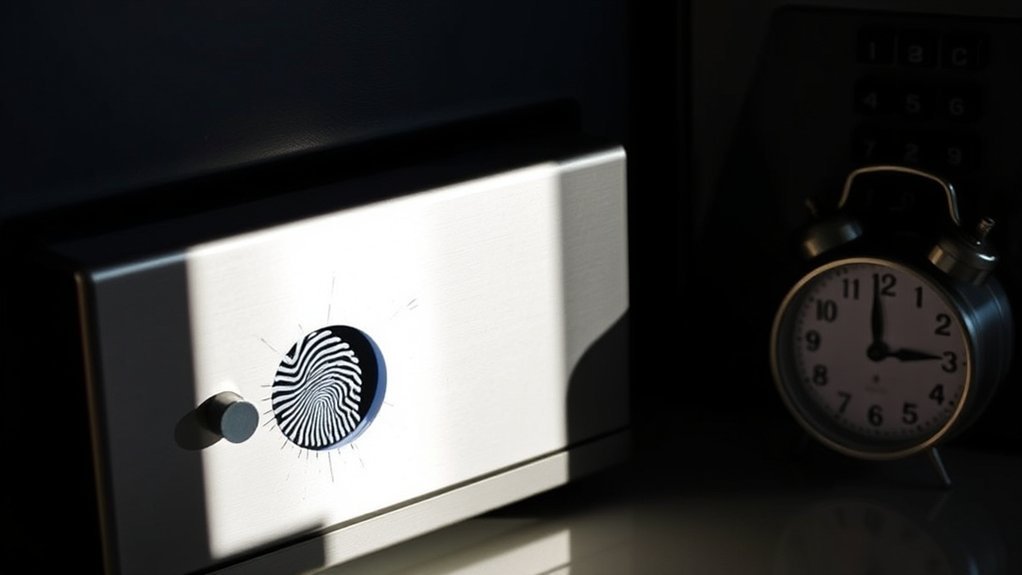When considering gun safes, you’ll find yourself weighing the merits of biometric versus keypad options. Biometric safes promise quick access and advanced security, leveraging your unique fingerprint. However, they can falter in certain conditions. On the other hand, keypad safes offer simplicity and affordability, but they come with their own vulnerabilities. Understanding these nuances is essential as you navigate your choices. So, what factors should you prioritize in your decision?
Understanding Biometric Gun Safes
Biometric gun safes are designed to provide firearm owners with rapid access through fingerprint recognition technology. This biometric technology allows for quick access, essential in emergencies, while accommodating multiple fingerprints for authorized users, such as family members. Advanced security measures, including encryption and tamper-proof designs, enhance access control and deter unauthorized attempts. However, reliability can be a concern, particularly during power outages or battery failures, as many safes require a continuous power source. Additionally, environmental factors like dirt or moisture on fingers or the scanner can affect performance, potentially leading to access issues. Understanding these aspects is important for firearm owners considering a biometric safe, as they weigh the potential security benefits against reliability challenges.
Advantages of Biometric Gun Safes

Biometric gun safes offer rapid access, allowing you to gain entry in seconds with just your fingerprint, which can be a lifesaver during emergencies. Their advanced security features, like encryption and tamper-proof designs, greatly enhance the safety of your firearms. Plus, they eliminate the hassle of remembering codes or carrying keys, reducing the chances of unauthorized access.
Quick Access Benefits
When it comes to quick access during emergencies, biometric gun safes shine with their rapid fingerprint recognition capabilities. You can gain entry to these safes in less than a second, ensuring immediate retrieval of firearms when it matters most. Unlike keypad safes, you won’t need to remember codes or carry keys, considerably reducing the risk of forgetting access methods under stress.
Key benefits of biometric gun safes include:
- Quick access for authorized users, enhancing gun safety.
- Ability to store multiple fingerprints for family or trusted individuals.
- Unique biometric data prevents unauthorized access, minimizing security risks.
In urgent situations, the efficiency of fingerprint scanners can make all the difference in protecting you and your loved ones.
High Security Features
While traditional safes might rely on codes and keys, biometric gun safes offer unparalleled security through their use of fingerprint recognition technology. These safes use your unique biological traits, making unauthorized access through guessing or hacking nearly impossible. With advanced security elements like encryption and tamper-proof designs, they greatly enhance the security of your firearms against theft or tampering. You won’t need to remember access codes or carry keys; simply open the safe with a quick fingerprint scan. Many biometric gun safes even accommodate multiple user profiles, allowing family access with proper authorization. Plus, backup battery options guarantee you can always access your safe, even during power outages. Overall, biometric locks provide a level of security that traditional safes can’t match.
Disadvantages of Biometric Gun Safes

Although biometric gun safes offer modern convenience, they come with several disadvantages that can compromise their effectiveness. Here are some key concerns to contemplate:
- False rejections: Dirt, moisture, or improper finger placement can prevent you from accessing the safe.
- Power outages: Relying on electricity or batteries means you might face lockouts during power failures or if the batteries die.
- Technology failure: Malfunctions in the biometric locking mechanisms can create serious access issues, leaving you vulnerable.
Additionally, many biometric safes lack certification from reputable security organizations, raising doubts about their robustness. Environmental factors, such as cuts or injuries on fingers, can also hinder the sensor’s ability to recognize your biometric data, further complicating access when you need it most.
Advantages of Keypad Gun Safes
Keypad gun safes present a reliable alternative to biometric options, addressing several concerns users may have about accessibility and functionality. One significant advantage is the customizable security they offer; you can create personalized access codes tailored to your preferences. Unlike biometric safes, these keypad models operate without batteries, ensuring consistent access even during outages. Their affordability makes them a great choice for budget-conscious users. Additionally, the straightforward operation minimizes the risk of technical glitches, providing reliable performance without the complexities of biometric technology. For convenience, you can easily share access codes with trusted individuals, enhancing usability in multi-user scenarios. Overall, keypad gun safes blend security, performance, and convenience effectively, making them an appealing option.
Disadvantages of Keypad Gun Safes
Even with their many advantages, keypad gun safes have notable disadvantages that can impact their effectiveness.
- Vulnerability to Unauthorized Access: If someone guesses or shares your access codes, your security is compromised.
- Risk of Being Locked Out: Forgetting access codes can leave you locked out, especially in urgent situations.
- Inconsistent Performance: Mechanical components can wear down over time, leading to unreliable functioning.
Additionally, keypad locks generally rely on battery power, which means a dead battery can prevent access. Unlike biometric safes, keypad models often lack the ability to store multiple user profiles, making it harder for family members to gain access. These factors can greatly hinder the reliability and security you expect from a gun safe.
Making the Right Choice for Your Needs
When you’re choosing between biometric and keypad gun safes, it’s essential to assess security features that align with your needs. You should also evaluate how quickly you can access your firearm in an emergency and consider your budget to find the best fit. Balancing these factors will help you make an informed decision that prioritizes both safety and convenience.
Assessing Security Features
As you assess security features in your choice between biometric and keypad gun safes, it is crucial to weigh the advantages and disadvantages of each option.
- Biometric fingerprint technology offers enhanced security but can be affected by dirt or moisture.
- Keypad safes provide easy access and consistent performance, but they may pose a risk if codes are shared or guessed.
- Consider your security needs and budget, as biometric safes generally come with a higher price tag.
Ultimately, the level of security you require, the ease of access you desire, and the potential for lock failure during power outages should guide your decision. Weigh the pros and cons of both options to find the best fit for your situation.
Evaluating Access Speed
Choosing between biometric and keypad gun safes hinges considerably on access speed, particularly in situations where every second counts. Biometric gun safes excel in this area, often granting entry in under a second with a fingerprint scan, providing rapid access during emergencies. In contrast, keypad gun safes require you to input codes, which can delay access if you forget or mistype them. While biometric safes allow for multiple fingerprint profiles, making access easier for authorized users, environmental factors like dirt or moisture can hinder their performance. Keypad safes, however, are generally less affected by such conditions, ensuring more consistent access. Ultimately, consider how access speed impacts your security needs when making your decision.
Budget Considerations
Access speed is just one factor to evaluate; budget plays a significant role in selecting the right gun safe for your needs. Biometric gun safes typically cost more due to advanced technology, ranging from $100 to over $400, while keypad safes are budget-friendly, often between $50 and $200.
Consider these budget considerations:
- Long-term costs, including battery replacements for biometric safes
- Maintenance needs, with keypad safes generally requiring less upkeep
- Affordability of models that offer a combination of features, like biometric and keypad access
Ultimately, if you’re budget-conscious, weighing the upfront costs against potential long-term expenses will help you make an informed choice that meets your security and financial needs.
Conclusion
In choosing between biometric and keypad gun safes, consider your unique needs and environment. For instance, if you live in a humid area, a biometric safe might struggle with moisture, leading to access issues during emergencies. Conversely, if you’re prone to forgetting codes, a keypad safe could become a liability. Weighing these factors guarantees you select a safe that offers both security and convenience tailored to your lifestyle, ultimately protecting what matters most to you.

